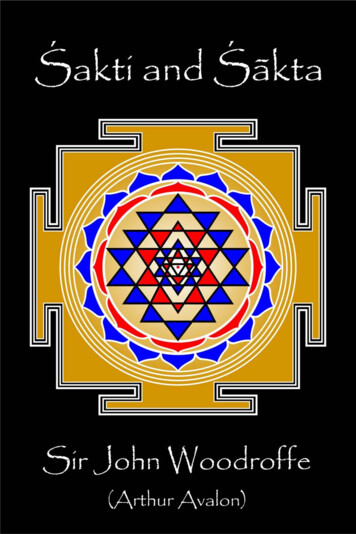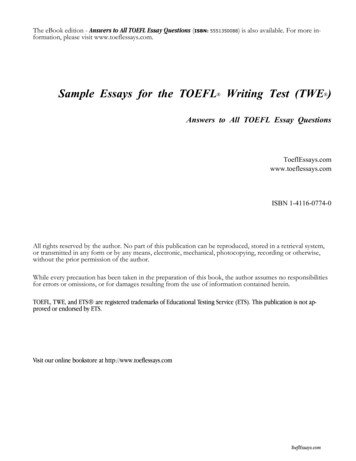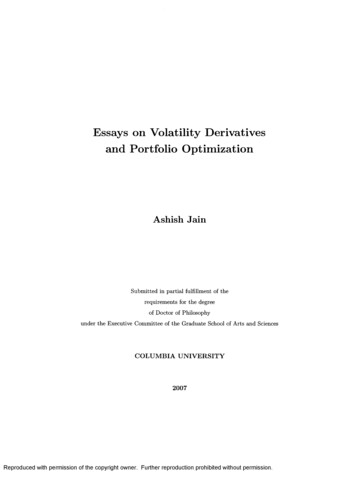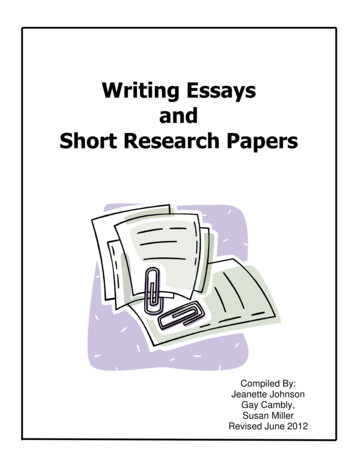
Transcription
ŚAKTI AND ŚĀKTAESSAYS AND ADDRESSES ONTHE ŚĀKTA TANTRAŚĀSTRABYSIR JOHN WOODROFFETHIRD EDITIONREVISED AND ENLARGEDCelephaïs PressUlthar - Sarkomand - Inquanok – Leeds2009
First published London: Luzac & co., 1918. Second edition, revisedand englarged, London: Luzac and Madras: Ganesh & co., 1919.Third edition, further revised and enlarged, Ganesh / Luzac,1929; many reprints. This electronic edition issued by CelephaïsPress, somewhere beyond the Tanarian Hills, and mani(n)festedin the waking world in Leeds, England in the year 2009 of thecommon error.This work is in the public domain.Release 0.95—06.02.2009May need furthur proof reading.Please report errors to dancingstar93@gmail.comciting release number or revision date.
PREFACETO THIRD EDITION.THIS edition has been revised and corrected throughout,and additions have been made to some of the originalChapters. Appendix I of the last edition has been made anew Chapter (VII) in the book, and the former Appendix IIhas now been attached to Chapter IV. The book hasmoreover been very considerably enlarged by the additionof eleven new Chapters. New also are the Appendices.The first contains two lectures given by me in French, in1917, before the Societé Artistique et Literaire Francaise deCalcutta, of which Society Lady Woodroffe was one of theFounders and President. The second represents the substance (published in the French Journal “Le Lotus bleu”)of two lectures I gave in Paris, in the year 1921, before theFrench Theosophical Society (October 5) and at the MuséeGuimet (October 6) at the instance of L’Association Francaise des amis de L’Orient. At this last meeting ProfessorDr. Sylvain Lévi was present and M. Nasson Oursel, also ofthe Collège de France, in an introductory speech said that,“as one increasingly explored the Tāntrik literature, hithertoalmost unknown, discovery is made not of more and moredissimilarities, but of a closer and closer connection betweenthese Scriptures and the other Religions.” The Tāntrik cultwas not, he said, “a mere superstitious imposition” (Simagréesuperstitieuse). “Its belief that man can realize the divinein him and outside him is the postulate also of all thosewho have divinised the ritual word as Brahman and ofall who seek in Yoga a theurgic equivalent.” The PressNotices (to which I might have added various addressesand letters of approval) are reprinted not merely to servetheir usual purpose as recommendatious to a possiblereader, but also as showing, firstly, the state of Indianopinion on the Śāstra, as an integral part of Hinduismv
ŚAKTI AND ŚĀKTAand not merely a pathological excrescence on it andsecondly, the effect produced on Western minds to whichthe Scripture was presented for the first time. Thus, Professor Evola (“Il Nuevo Paese”) has recently very trulyremarked that the Tāntrik system here described “offersmany suggestions to the West in virtue of its accentuationof Will and Power.” (Offrono grande suggestione per gliOccidentali in virtù del loro accentuare essenzialmente laparte della volontà e della potenza). To him (“Bilychnis”,October 1924) this Śākta system is one of the most important of Eastern systems (ora uno dei sistemi Orientali piuimportante) raising on a grand foundation a vast ensemble ofmetaphysic, magic and devotion (Su questo sfondo grandiosoi Tantra svolgono un vasto insieme metafisico, magico, e devozionale). Noteworthy too are the observations of ProfessorDr. Winternitz in the “Ostusiatische Zeitschrift” (1916 Heft3. See Chapter V of this book) that (as I have all along contended) the Tāntra Śāstras deserve a study which they havepreviously not received, and that they have been judgedwithout knowledge. (Aus dem gesagtem erhellt dass Avalonrecht hat wenn er erklärt dass mas bisher über dieseliteratur allzu oft geurteilt und noch mehr Abgeurteilt hatohne sie zu kennen und dass die Tantras es verdienen,besser bekanut zu werden, als es bisher der fall gewesenist). This statement is the more weighty, as this critic isnot attracted by the Scriptures which he takes to be predominantly magical. As to this see what I have said inChapter V post.The philosopher Herman Keyserling in his now celebrated work “Das Reise Tagebuch Einer Philosophen”; recentlytranslated into English (“The Travel Diary of a Philosopher”), writes (pp. 223-224) of the Tantras that “howeverextravagant some of its sayings may sound, their meaningis clear and their fundamental ideas are in accordance withreason”. And again (p. 231), “I personally am convincedthat the teachings of the Tantra are correct on the whole,but that it is nevertheless in the order of things that theyvi
PREFACE TO THIRD EDITIONmeet with less and less observance for the development ofhumanity tends away from ritualism.” I have my doubtsas regards this last point. A strong ritualistic revival is inforce today and there is likely to be always the reciprocalreaction of Puritanism and Ritualism.I cannot do better than conclude these foreign criticismswith a note of the recent observations of a French writerin the Journal “L’Humanite” in which, referring to theFrench edition (Bossard, Paris) of A. and E. Avalon’s “Hymnsto the Goddess", and other works on the Śāstra, he hasnothing to say about its “puerility” or “worthlessness” but,on the contrary, writes: “These conceptions display an astonishing philosophic subtlety (Une étonnante subtilité philosophique). This volume and others of the collection showthe interest which Oriental research has for all those whoare interested in the evolution of humanity, the futurecohesion of which may be expected because of thecommunity of origin. We have still to learn much ofAsia. Some Russian revolutionaries have called their country Eurasia, as being the junction of the two Continents.There is truth in this. If we persist in our Western decadence, it may be that the seat of civilization will pass tothe East, the great primitive source of generations of men.Some poets have already said:—Europe is no more andthat Asia alone contains the future in its secret valleys.”With such poets and their prophecies of Western decadenceI disagree. Nevertheless, it is rightly said that we, Occidentals, can complete our own culture and render ourthoughts more complete and humane by observation ofthe Orientals and establishing contact with the conscienceof modern Asia; that between these extreme points of time,past and present, we shall discover fecund traditions, and ourdesire for a spiritual universality will find its satisfaction.It is to such minds that the great concepts of India willmake appeal. I am glad to report that years of workhave borne some fruit in the shape of a more discriminatingjudgment. For myself it is enough, as it has always been,vii
ŚAKTI AND ŚĀKTAto my here in the words of the French writer Dunoyer,“I do not oppose.Nor do I propose.I merelyexpose.” But for this last we must both know the factsand understand them. “Get knowledge, and with gettingget understanding.” This process on my own part has ledto the revision of some of the matter reprinted so as tobring it into accordance with my present knowledge andopinions.BYGDIN, VALDRES8th August 1927.}J.W.[Note: The list of works translated / edited by “Arthur Avalon” whichappeared at the end of the 1929 edition is retained. The 25 pages of PressNotices following, alluded to above, are here omitted, as some pages weremissing in my copy-text. They may be restored in a later edition. Theworks of John Woodroffe and “Arthur Avalon” on the Tantra Śāstra havefor the most part remained in print in various editions from the 1950s tothe present date. In case there is any doubt, it should be pointed out thatthe volumes of the Tāntrik texts series are editions of the Sanskrit textsand do not include English translations unless this is explicitly stated inthe listing. — T.S.]viii
PREFACETO SECOND EDITION.THIS present edition is practioally a new work, for Ihave revised and added to all the original Chaptersand written six new ones (1, 5, 6, 10, 14 and 15). Seven ofthe original Chapters embodied a set of Lectures deliveredbefore, and at the request of, the Vivekānanda Societyin Calcutta, a circumstance which will explain both themanner of them as also the “Conclusions” with which thevolume closes.These Lectures and other collected papers traverse newground in the Literature of Indian Reborn, for they are thefirst attempt to give an authenticated and understandinggeneral account, from the Indian standpoint, of the chieffeatures of the Doctrine and Practice of that class of Indianworshippers who are called Sāktas, that is, those whoadore the Divine Power (Mahāśakti) as Mahādevī, theGreat Mother (Magna Mater) of the universe. As thisreligious community shares in common with others certainprinciples and practices, the work is also necessarily anaccount of the worship and spiritual disciplines calledSādhanā which, in varying forms, are adopted by all communities of Indian worshippers (Sādhakas) governed bythe Āgama and its numerous scriptures called Tantras.These Shāktas are to be found all over India, but are largelypredominant in Bengal and Assam, in which former Province I have lived for about the last thirty years, and withthe belief of whose people therefore I am more closely acquainted than with any other. And this, in part, accountsfor the fact that I deal with their faith. Their doctrine andpractice have not hitherto been understood and have beenill-spoken of, due to abuses which have occurred among themembers of some sections of the community. If, then, Ihave succeeded in giving in this and other works a justix
ŚAKTI AND ŚĀKTAaccount of the Scripture, and in reducing such evil as has beencharged against some of its adherents to its right proportions, I shall be glad to have been in a position to makesome small return to a Land which, more than any other,has been my home: and to which I am, in manifold ways,indebted.Though, as I said in the last edition, I rate highlyŚākta doctrine and (with some exceptions) Śākta rituals, Ido not commit myself to the acceptance of everything whichany Śākta may have held or done. And though I have furnished argument in favour of this much-abused faith andpractice, I am not here concerned to establish the truthand rightness of either. It is sufficient, for my presentpurpose to show that it is reasonable, and that neither it,nor “the Tantra” is the absurd and altogether immoralthing which some have supposed it to be. My attitudeis an objective one. I have endeavoured to explain mysubject as simply and lucidly as the recondite matterstreated of allow, from an entirely detached and unprejudiced standpoint.In giving an account of lndian beliefs and practices, we,who are foreigners, must place ourselves in the skin of theHindu, and must look at their doctrine and ritual throughtheir eyes and not our own. It is difficult, I know, for mostto do this: but until they can, their work lacks real value.And this is why, despite their industry and learning, theaccounts given by Western authors of Eastern beliefs sogenerally fail to give their true meaning. Many, I think, donot even make the attempt. They look at the matter fromthe point of view of their own creed, or, (what is much worse),racial prejudice may stand in the way of the admission ofany excellence or superiority in a coloured people. Themethod I follow is that of the Indian commentator, who,for the nonce, adapts himself to the standpoint of the doctrine which he explains. I mention this because two of mycritics seem to think that my object is to establish the superiority of this particular form of Vedāntik teaching overx
PREFACE TO SECOND EDITIONothers. One may, of course, have one’s personal preferences,but it is not my object here to establish the superiority ofany school of Indian thought. This is a matter whicheach will decide for himself. One of these critics has said,“The Tantras are claimed to be the specific Śāstra for the.Kaliyuga by the Tāntriks. Mr. Avalon seems to havetaken these latter at their own valuation; and this hasconsiderably influenced his whole estimate of these booksas Śāstras or authorities on the Hindu system. In doingso, he has fallen into a series of curious errors in regard toother and particularly the Vaiṣ ṇ avic denominations.”This criticism which was passed on one of my earlier bookshas been repeated as regards this. What these errors aremy critics have not told me. I did not intend to deal,nor am I aware of having dealt, with the Vaiṣ ṇ ava systembeyond pointing out in the most general way that there isa Vaiṣ ṇ ava and Śaiva as well as a Śākta Āgama. I havecriticized neither this nor the Śaiva Āgama, both of whichschools are also of high value. Though the instructedWestern reader is aware that thereare other interpretationṣof Vedānta besides that of Śamkara, many write as if theVedānta meant his Māyāvāda. This is not so. Vedāntais Upaniṣ ad of which there are varying interpretations.Each has certain merits and certain defects, as must necessarily be the case when we apply logic to that which isalogical. Indeed the point which I took, and which I hadhoped I had made plain was this—Tantra Śāstra does notsimply mean the Śākta Tantra.The latter is onlyone division of Āgama which has to-day three main schools,Śākta, Śaiva, and Vaiṣ ṇ ava. There are certain thingscommon to all. There are certain matters wherein theydiffer. When it is said that the Tantra Śāstra is thescripture of the Kali age, what is meant is that the Āgamain all its schools is that. There are some ancient schoolsof Vaiṣ ṇ ava Āgama such as the Pañcarātra, and thereare comparatively modern developments of Vaiṣ ṇ avateaching and practice such as that of the great Caitanya.xi
ŚAKTI AND ŚĀKTA“Tāntrik” does not mean only “Śākta”.This is themain error of these critics and others. Naturally, I havetaken the Śāktas “at their own valuation,” for my objectis not to show that they are right and others wrong, or thecontrary, but to state what they, the Śāktas, hold. Theyalone can say this. A quarrelsome attitude as regards othercreeds is the mark of a lower mind and of what theŚāktas call a Paśu. I believe a different position isassumed by all higher Sādhakas to whatever denominationthey belong. Certainly a wide and liberal view is takenby the Śākta. The Sammohana Tantra (Ch. IX) saysthat “it is only a fool who sees any difference betweenRāma and Śiva.” Each has his path which, if sincerelypursued, will procure for him the fruit of it. Whethersome paths in the Indian or other Religions are better andsurer than others, and gain for their followers greater fruit,I do not here discuss.J. W.xii
PREFACETO FIRST EDITION.THE present work deals with its subject only in a verygeneral and, as far as the matter permits, popular way.I refer those who wish to pursue it further to the other workson Tantra Śāstra which are published under the name“Arthur Avalon” to denote that they have been writtenwith the direct co-operation of others and in particularwith the assistance of one of my friends who will not permitme to mention his name. I do not desire sole credit forwhat is as much their work as mine. I, in particular, refermy reader to the series of Articles on the Mantra Śāstrawhich I wrote for the “Vedānta Kesarī” now reprinting (sincepublished as “Garland of Letters”) and to the “SerpentPower” shortly to be published (published in 1918, 2nd(present) Edition, 1925). In this last there is given, for thefirst time, the rationale of Yoga through the Kuṇ ḍ aliṇ īŚakti, the outlines of which are indicated in Chapter XVI ofthis volume.The Śākta Tantra is a Sādhanā Śāstra of Monistic(Advaitavāda) Vedānta. It is to me a profound and powerfulsystem, and its doctrine of Śakti or Divine Power isone of the greatest evolved, through spiritual intuition, bythe human mind which, according to its teaching, is a manifestation of the Divine Consciousness Itself (Śiva).The Doctrine is laid on grand lines and what is not, inthis Vast Land of great distances?I write this on a high plateau in Palamow, and lookacross a wide stretch of tall grass with tips of waving silver,the home, until about nine years ago (when the place wasfirst opened), of the wild bison. The green and silverof the Prairie is splashed here and there with patches oforange flower, which the blazing sun jewels with its pointsof light. The near distance shows the water of a mountaintarn and two clumps of trees—the groves of worship of theancient Kolatrian peoples. Here a sparse remnant adoreto-day, as did their ancestors thousands of years ago. Ofxiii
ŚAKTI AND ŚĀKTABrāhmanism or other Aryan faith, there is no sign. Beyond,the grassland rises to meet the great length of amounting hill-forest, dark green against the blue of distance,in which other Hill tops beckon forward the curious mindwith their lure of mystery. And this lure is all around, forthe upland is some fifteen hundred feet below withwooded valleys, valleys on the East black with great Salforests, which, as those of the upland, are the haunt of bear,tiger and sambur,—wild forests, lit only here and there byrare open spaces, and the glinting stream and white sandsof the Koel River. Beyond the valleys, and all around theupland are a circle of Hills rising on the East, wave uponwave. Here man, who has not known himself and hisgreatness seems nought, and Nature all, a feeling whichdeepens as night falls on the earth with quick assault, thedark dome of heaven sparkling with the light of countlessrising stars, fading again at Dawn as the Visible Devatā,the resplendent joyous Sun, the Eye of Viṣ ṇ u, arises fromout the “Eastern Mountain”.Such a vast scene is but one of many in this, itself vast,secular, and awe-inspiring land. Such a view, we mayimagine, was displayed before the eyes of the incomingAryan peoples. Upon them the influence of the Soil fell,filling them with awe. The Spirit, manifesting in this Sacred Earth, at length revealed Itself in their minds. Withinthem arose the Inner Sun, which is the Light of all, unveiling to the eye of mind truths hidden in its subtle garb ofthought. These tenuous veils again fell away, when, bythe intuition of the forest-sages, was realized the SpiritualEther of Consciousness, whose Mother-Power (Śakti) asWill, Thought and Action ever personalizes as the life ofthis magnetic stretch of earth which is India, as the worldof which it is an head-ornament, and as (in the words of theIndian Scripture) the countless other universes, which arebut the dust of Her Sovereign Feet.NETURHAT,11th October 1918.}J.W.xiv
CONTENTS.SECTION .X.XI.XII.XIII.Bhārata Dharma . .The World as Power (Śakti)The Tantras.Tantra and Veda Śāstras . .The Tantras and ReligionŚāktas.Śakti and Śākta . .Is Śakti Force? . .Cīnācāra.Tantra Śāstras in China . .A Tibetan Tantra . .Śakti in Taoism . .Alleged Conflict of Śāstras . 91199212220235SECTION 2.—DOCTRINALXIV.XV.XVI.XVII.XVIII.XIX.XX.Cit Śakti.Māya Śakti.Matter and ConsciousnessŚakti and Māyā . .Śākta AdvaitavādaCreation.The Indian Magna Mater.240272316326342355383.407428SECTION 3.—RITUALXXI.XXII.Hindu Ritual.Vedānta and Tantraxv.
ŚAKTI AND he Psychology of Hindu ReligiousRitual.Śakti as Mantra . .Varnamālā.Śākta Sādhanā or Ordinary RitualPañcatattva or Secret Ritual.Matam Rutra (The Right and WrongInterpretation).434452484490553608SECTION 4.—YOGA AND CONCLUSIONSXXIX.XXX.XXXI.Kundaliṇ ī Śakti . .(The Serpent Power)The Āgamas and the FutureConclusions. .632659673APPENDICES(1) Quelques Concepts Fondamentaux des Hindous(2) Quelques Observations sur le Rituel Hindouxvi688709
ŚAKTI AND ŚĀKTACHAPTER I.INDIAN RELIGION AS BHĀRATA DHARMA.AFRIEND of mine who read the first edition of this booksuggested that I should add to it an opening Chapter,stating the most general and fundamental principles of thesubject as a guide to the understanding of what follows,together with an outline of the latter in which the relationof the several parts should be shown. I have not at presentthe time, nor in the present book the space, to give effectto my friend’s wishes in the way I would have desired, butwill not altogether neglect them.To the Western, Indian Religion generally seems a“jungle” of contradictory beliefs amidst which he is lost.Only those who have understood its main principles canshow them the path.It has been asserted that there is no such thing asIndian Religion, though there are many Religions in India.This is not so. As I have already pointed out (“Is IndiaCivilized?”) there is a common Indian religion which Ihave called Bhārata Dharma, which is an Aryan religion(Āryadharma) held by all Āryas whether Brahmanic,Buddhist or Jaina. These are the three main divisions ofthe Bhārata Dharma. 1 exclude other religions in India,namely, the Semitic religions, Judaism, Christianity andIslam. Not that all these are purely Semitic. Christianitybecame in part Āryanized when it was adopted by the Western Āryans, as also happened with Islam when acceptedby such Eastern Āryans as the Persians and the Āryanizedpeoples of India.1
ŚAKTI AND ŚĀKTAThus Sufiism is either a form of Vedānta or indebtedto it.The general Indian Religion or Bhārata Dharmaholds that the world is an Order or Cosmos. It is not aChaos of things and beings thrown haphazard together,in which there is no binding relation or rule. The worldorder is Dharma, which is that by which the universe isupheld (Dhāryate). Without Dharma it would fall topieces and disolve into nothingness. But this is not possible,for though there is Disorder (Adharma), it exists, and canexist only locally, for a time, and in particular parts of thewhole. Order however will and, from the nature of things,must ultimately assert itself. And this is the meaning ofthe saying that Righteousness or Dharma prevails. Thisis in the nature of things, for Dharma is not a lawimposed from without by the Ukase of some Celestial Czar.It is the nature of things; that which constitutes themwhat they are (Svalakśaṇ adhāraṇ āt Dharma).It isthe expression of their true being and can only ceaseto be, when they themselves cease to be.Belief inrighteousness is then in something not arbitrarily imposed from without by a Law-giver, but belief in a Principle of Reason which all men can recognize for themselvesif they will. Again Dharma is not only the law of eachbeing but necessarily also of the whole, and expresses theright relations of each part to the whole. This whole isagain harmonious, otherwise it would dissolve. The principlewhich holds it together as one mighty organism is Dharma.The particular Dharma calls for such recognition and actionin accordance therewith. Religion, therefore, which etymologically means that which obliges or binds together, isin its most fundamental sense the recognition that the worldis an Order, of which each man, being, and thing, is a part,and to which each man stands in a definite, establishedrelation; together with action based on, and consistent with,such recognition, and in harmony with the whole cosmic2
BHĀRATA DHARMAactivity. Whilst therefore the religious man is he who feelsthat he is bound in varying ways to all being, the irreligiousman is he who egoistically considers everything from thestandpoint of his limited self and its interests, without regardfor his fellows, or the world at large. The essentially irreligiouscharacter of such an attitude is shown by the fact that, if itwere adopted by all, it would lead to the negation of Cosmos,that is Chaos. Therefore all Religions are agreed in the essentials of morality and hold that selfishness, in its widest sense,is the root of all sin (Adharma). Morality is thus the truenature of man. The general Dharma (Sāmānya Dharma)is the universal law governing all, just as the particularDharma (Viśeṣ a Dharmi) varies with, and is peculiar to,each class of being. It follows from what is above statedthat disharmony is suffering. This is an obvious fact.Wrong conduct is productive of ill, as right conduct is productive of good. As a man sows, so he will reap. Thereis an Immanent Justice. But these results, though theymay appear at once, do not always do so. The fruit of noaction is lost. It must, according to the law of causality,which is a law of reason, bear effect. If its author does notsuffer for it here and now in the present life, he will do soin some future one. Birth and death mean the creation anddestruction of bodies. The spirits so embodied are infinitein number and eternal. The material universe comes andgoes. This in Brahmanism has been said (see SanātanaVaidika Dharma by Bhagavān Das) to be “the Systole andDiastole of the one Universal Heart, Itself at rest—themoveless play of Consciousness”. The appearance anddisappearance of the Universe is the nature or Svabhāvaof That which it ultimately is. Its immediate causeis Desire, which Buddhism calls Tṛ ṣ ṇ ā—or Thirst,that is desire or thirst for world-enjoyment in the universeof form. Action (Karma) is prompted by desire and breedsagain desire. This action may be good (Dharma) or bad(Adharma) leading to enjopent or suffering.Each3
ŚAKTI AND ŚĀKTAembodied soul (Jīvātmā) will be reborn and reborn into theworld until it is freed from all desire. This involves thedoctrine of Re-incarnation. These multiple births anḍdeaths in the transmigratory worlds are called Samsāraor Wandering. The world is a Dvandva, that is a compositeof happiness and suffering. Happiness of a transitory kindmay be had therein by adherence to Dharma in followingKāma (Desire) and Artha (the means) by which lawfuldesires may be given effect. These constitute what Brahmanism calls the Trivarga of the Puruṣ hārtha, or threeaims of sentient being. But just as desire leads to manifestation in form, so desirelessness leads away from it.Those who reach this state seek Mokṣ ha or Nirvāṇ a (thefourth Puruṣ ārtha): which is a state of Bliss beyondthe worlds of changing forms. For there is a rest fromsuffering which Desire (together with a natural tendencyto pass its right limits) brings upon men. They must, therefore, either live with desire in harmony with the universalorder, or if desireless, they may (for each is master of hisfuture) pass beyond the manifest and become That which isMokṣ a or Nirvāṇ a. Religion, and therefore true civilization, consists in the upholding of Dharma as the individualand general good, and the fostering of spiritual progress,so that, with justice to all beings, true happiness, whichis the immediate and ultimate end of all Humanity, andindeed of all being, may be attained.Anyone who holds these beliefs follows the BhārataDharma or common principles of all Āryan beliefs. Thusas regards God we may either deny His existence (Atheism)or affirm it (Theism) or say we have no sufficient proof oneway or another (Agnosticism). It is possible to accept theconcept of an eternal Law (Dharma) and its sanctions in aself-governed universe without belief in a personal Lord(Īśvara).So Sāñkhya, which proceeds on intellectualproof only, does not deny God but holds that the being ofa Lord is “not proved”.4
BHĀRATA DHARMAThere are then based on this common foundation threemain religions, Brahmanism, Buddhism and Jainism. .Ofthe second, a great and universal faith, it has been saidthat, with each fresh acquirement of knowledge, it seemsmore difficult to separate it from the Hinduism out of which itemerged and into which (in Northera Buddhism) it relapsed.This is of course not to say that there are no differencesbetween the two, but that they share in certain general andcommon principles as their base. Brahmanism, of whichthe Shākta doctrine and practice is a particular form, acceptsVeda as its ultimate authority. By this, in its form as thefour Vedas, is revealed the doctrine of the Brahman, the“All-pervader,” the infinite Substance which is in Itself(Svarūpa) Conscioumess (Caitanya or Cit) from Whichcomes creation, maintenance and withdrawal, commonlycalled destruction (though man, not God, destroys), andWhich in Its relation to the universe which the Brahmancontrols is known as Īśvara, the Ruling Lord or Personal God. Veda both as spiritual experience and theword “which is heard” (Shruti) is the warrant for this.But Shruti, as the ultimate authority, has received variousinterpretations and so we find in Brahmanism, as in Christianity, differing schools and sects adopting various interpretations of the Revealed Word. Veda says “All this(that is, the Universe) is Brahman.” All are agreed thatBrahman or Spirit is, relatively to us, Being (Sat), Consciousness (Cit) and Bliss (Ānanda).It is Saccidānanda.̣But in what sense is “This” (Idam) Brahman?TheMonistic interpretation (Advaitavāda), as given for instanceby the great scholastic Śañkarācārya, is that there is acomplete identity in essence of both. There is one Spirit(Ātmā) with two aspects; as transcendent supreme (Paramātmā), and as immanent and embodied (Jivātmā). Thetwo are at base one when we eliminate Avidyā in the formof mind and body. According to the qualified Monism(Viśiṣ ṭ ādvaita) of the great scholastic Rāmānuja, “This”5
ŚAKTI AND ŚĀKTAis Brahman in the sense that it is the body of the Brahman,just as we distinguish our body from our inner self. According to the Dualists (Dvaitavāda) the saying is interpretedin tern of nearness (Sāmīpya) and likeness (Sādṛ iśya)for, though God and man are distinct, the former so pervades and is so unextricably involved in the universe ascreator and maintainer, that the latter, in this sense, seemsto be Brahman through proximity.Then again there is the Śuddhādvaita of that branch ofthe Āgamas which is called Śaivasiddhānta,
nor "the Tantra" is the absurd and altogether immoral thing which some have supposed it to be. My attitude is an objective one. I have endeavoured to explain my subject as simply and lucidly as the recondite matters treated of allow, from an entirely detached and unpre-judiced standpoint. In giving an account of lndian beliefs and practices .











